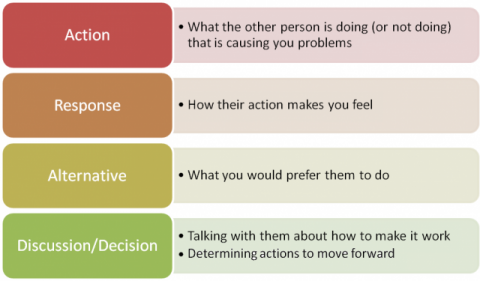Let’s face it…much of our success and satisfaction within the workplace (and beyond for that matter!) arises from the effectiveness of our interactions with others.
Sometimes, the challenge can be in clearly understanding what others need, want and expect from us. At other times, challenges can arise when we aren’t sure of or don’t adequately express our needs, wants and expectations of others: we might be concerned about being seen as too pushy or starting a confrontation for example, or it might be that we just don’t know how to clearly express ourselves.
A popular inclusion in a couple of our Short N Sharp Training programs is the A.R.A.D. model, which can be used as a simple framework to help you better express your needs, wants and expectations of others. An overview of the model is presented below:

Here are some key points to help you make best use of the model:
- Spend some time preparing for the discussion: Sit down and plan how you intend to manage the conversation. Use the model to prepare the points you want to work through and write them down. Using the model will help you stay on track, ensure you say what you need to say and don’t get caught up in your own emotions or distracted by the responses of the person you are speaking with.
- Action – it’s important that you are specific about the actions/behaviours of the other person that are not meeting your needs, wants and expectations. “The way you talk to others in the team is a problem”, for example, is simply not specific enough. Is it that they not communicating regularly enough? Are they using inappropriate or potentially offensive language? Is there an issue with their body language? Is it the tone they use when communicating with others? You need to be prepared to describe the specific problem(s) before clarifying your specific expectations.
- Response – What response or impact is their actions/behaviour having? Is it that others are complaining, not wanting to work with them and/or is it affecting you at a personal level? Often people are not aware how others are responding to their actions/behaviours, so it can be quite powerful to give them this insight.
- Alternative – Be clear about what you want, need and expect the person to do differently. Again, it will be important to be specific. “Communicate better” or “Provide better customer service” is not adequate. Tell them exactly what you want, need and expect.
- Discussion/Decision – Once you have clearly expressed your needs, seek feedback from the other person. By all means discuss it with them but stay firm in terms of your needs, wants and expectations. Finally, decide and communicate what will happen from this point: it may be that you establish a time for a further meeting for example, or it might be providing access to training or other support to help them meet your expectations. Whatever it is, make sure it’s clear and that it’s understood.
Sure, some of the conversations you might need to have could still prove challenging, but armed with the A.R.A.D. model, a bit of preparation and some practice, you should find it at least a little easier to express your needs.

